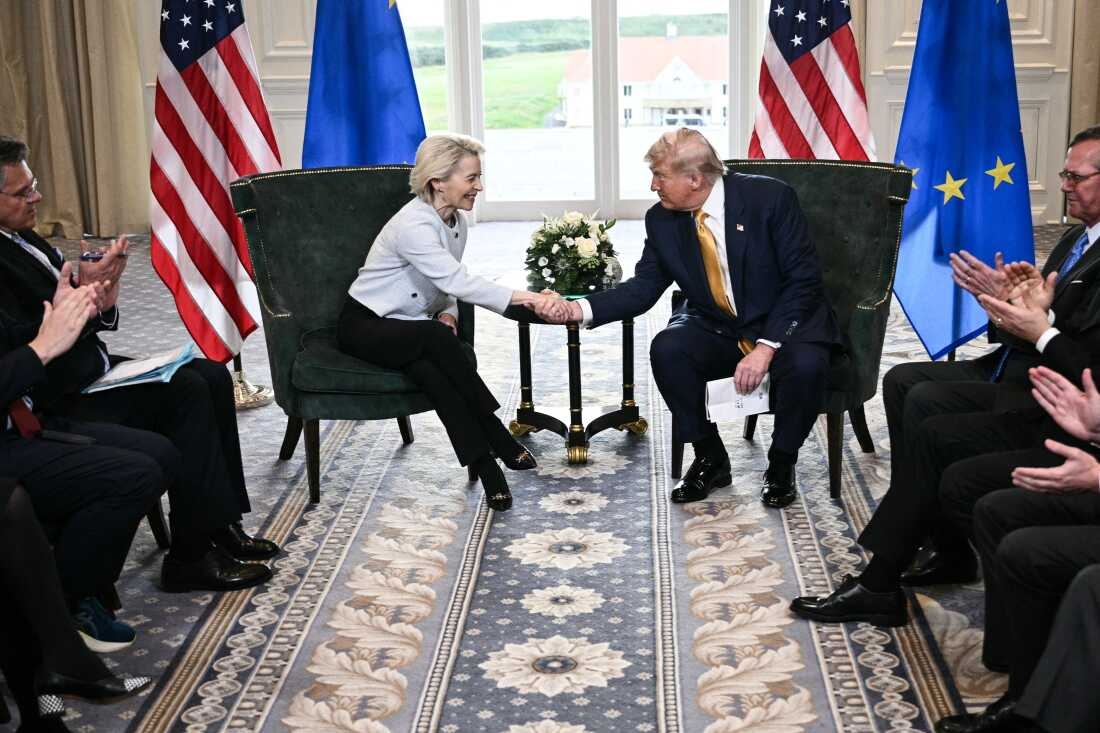Trump Secures U.S.–EU Trade Deal with 15% Tariffs Amid $1.35 Trillion Investment Pledge
Trump Secures U.S.–EU Trade Deal with 15% Tariffs Amid $1.35 Trillion Investment Pledge
By
Leah Rosenfeld
Last updated:
July 28, 2025
First Published:
August 6, 2025

Photo: Tekedia
U.S. and EU Finalize Sweeping Trade Pact with New 15% Tariff Framework
In a high-stakes development ahead of a looming tariff deadline, former President Donald Trump and European Commission President Ursula von der Leyen jointly announced a landmark U.S.–EU trade agreement on Sunday. The pact includes 15% tariffs on a wide range of European imports into the U.S., a move that defuses mounting trade tensions and sets the stage for deeper transatlantic economic ties.
The deal comes after months of speculation and negotiation, with Trump previously threatening to impose 30% tariffs on EU imports. The final agreement halves that figure and is accompanied by an ambitious $750 billion energy purchase commitment by the EU and an additional $600 billion in new investment into the U.S. market.
Key Terms of the Deal
- Tariff Implementation: A 15% tariff will now apply to most EU goods entering the U.S., including automobiles, which had been at the center of the dispute.
- Exemptions: Certain categories—aircraft components, pharmaceuticals, and select chemicals—are exempt from the new tariffs.
- No Layering: Existing tariffs will not be compounded. The new 15% rate replaces prior ones rather than adding to them.
- EU Investment Commitments:
- $750 billion in U.S. energy purchases over the next decade.
- $600 billion in additional investments into American infrastructure, technology, and financial assets.
- Unspecified commitments to purchase “hundreds of billions” in U.S. military equipment, according to Trump.
“This is the biggest trade agreement we've ever made. It’s strong, fair, and deeply strategic,” Trump said at a joint press conference.
Von der Leyen called the negotiations “tough but productive,” emphasizing that the agreement ensures “a new era of cooperation and economic certainty.”
European Reaction: Relief, But With Reservations
The announcement was met with a mix of relief and cautious optimism across European capitals, where fears of a trade war had been rising. EU officials had been preparing retaliatory tariffs and even invoked the possibility of deploying the bloc’s Anti-Coercion Instrument, often referred to as its “trade bazooka.”
Ireland
“Ireland welcomes this clarity in the U.S.–EU trading relationship,” said Prime Minister Micheál Martin, while also acknowledging that the new tariffs “will make trade more expensive and challenging.”
Germany
Chancellor Friedrich Merz applauded the outcome, saying it spares Germany’s crucial auto sector from devastating consequences.
“With tariffs slashed from 27.5% to 15% on autos, this deal prevents a major hit to Germany’s export-driven economy,” he said in an official statement.
Netherlands
Prime Minister Dick Schoof noted that while “no tariffs would have been better,” the agreement brings clarity and predictability that Dutch businesses need to plan forward.
Italy
Italian Prime Minister Giorgia Meloni emphasized the importance of “stability over escalation,” calling the 15% tariff rate “sustainable” as long as it consolidates, rather than layers on top of, earlier tariffs.
The Broader Economic Context
The U.S.–EU trade relationship currently sits at a value of €1.68 trillion ($1.97 trillion) annually, encompassing goods and services. While the EU typically runs a goods surplus with the U.S., it sees a services deficit, resulting in a net surplus of about €50 billion.
The new trade deal attempts to address imbalances while also securing long-term supply chains and transatlantic cooperation in areas like energy security, advanced manufacturing, and defense procurement.
Avoiding a Trade War
This agreement narrowly avoided what many analysts feared would become a tit-for-tat tariff escalation, which could have hurt both economies at a delicate time. EU lawmakers had already passed a counter-tariff package targeting U.S. agriculture, tech, and manufacturing sectors—measures that are now suspended.
Economists from the European Council on Foreign Relations say the compromise will stabilize currency markets and reduce the risk of capital flight, which had begun to rattle investor sentiment amid earlier threats of a full-blown trade dispute.
Final Thoughts
The U.S.–EU trade deal marks a strategic turning point in transatlantic relations. While the 15% tariffs are higher than what Europe wanted, they are significantly lower than Trump’s earlier threats. In return, the U.S. gains vast energy and capital commitments from the EU, and Europe sidesteps a tariff war that could have derailed its key industries.
As details unfold and timelines firm up, businesses on both sides of the Atlantic are expected to recalibrate supply chains, reevaluate price strategies, and prepare for a new normal in global trade policy.
Popular articles
Subscribe to unlock premium content
Disney’s Timeless Magic and How the Entertainment Giant Continues to Shape Culture and Innovation

Imran Khan’s Economic Missteps Amid Political Chaos in Pakistan

The Philippines’ Digital Shift How Remittances and BPO Are Fueling Growth

Disney’s Timeless Magic and How the Entertainment Giant Continues to Shape Culture and Innovation

Imran Khan’s Economic Missteps Amid Political Chaos in Pakistan

Disney’s Timeless Magic and How the Entertainment Giant Continues to Shape Culture and Innovation









